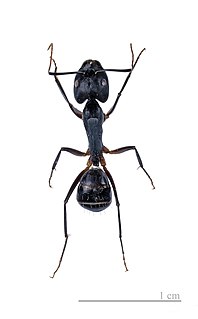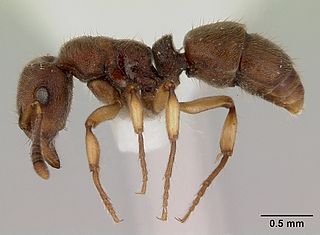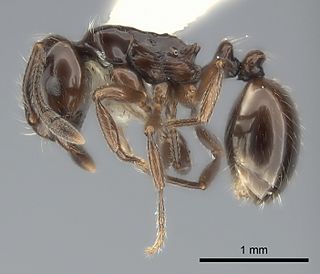
The Formicinae are a subfamily within the Formicidae containing ants of moderate evolutionary development.

Dorylinae is an ant subfamily, with distributions in both the Old World and New World. Brady et al. (2014) synonymized the previous dorylomorph subfamilies under Dorylinae., while Borowiec (2016) reviewed and revised the genera, resurrecting many genera which had previously been merged. Dorylinae genera are suggested to have evolved sometime between 102 to 74 million years ago, subsequently undergoing rapid adaptive radiation events during their early history.

Ponerinae is a subfamily of ants in the Poneromorph subfamilies group, with about 1,600 species in 47 extant genera, including Dinoponera gigantea - one of the world's largest species of ant. Mated workers have replaced the queen as the functional egg-layers in several species of ponerine ants. In such queenless species, the reproductive status of workers can only be determined through ovarian dissections. Ponerinae is a subfamily of ants within the family of Formicidae. These ants typically nest in soil, forest litter, or rotting logs, and are predacious. They primarily prey on isopods. They mostly live in small colonies of up to 200 workers. They can be found mostly in tropical environments, but have been found in southeastern Canada and New York. Female workers have twelve segmented antennae, whereas male workers have 13 segmented antennae.

Myrmicinae is a subfamily of ants, with about 140 extant genera; their distribution is cosmopolitan. The pupae lack cocoons. Some species retain a functional sting. The petioles of Myrmicinae consist of two nodes. The nests are permanent and in soil, rotting wood, under stones, or in trees.

Heteroponera brouni is a species of ant in the genus Heteroponera. It is endemic to the North Island of New Zealand, and the Three Kings Islands.

Monomorium bidentatum is a species of ant in the subfamily Myrmicinae. It is endemic to two South American countries, Chile and Argentina.

Crematogaster is an ecologically diverse genus of ants found worldwide, which are characterised by a distinctive heart-shaped gaster (abdomen), which gives them one of their common names, the Saint Valentine ant. Members of this genus are also known as cocktail ants because of their habit of raising their abdomens when alarmed. Most species are arboreal. These ants are sometimes known as acrobat ants.

Crematogastrini is a tribe of myrmicine ants with 64 genera and 8 fossil genera.

Acanthognathus is a genus of ants that are found in tropical Central and South America. There are 7 living species and 1 extinct species, Acanthognathus poinari, known only from fossil records.

Dolichoderus is a genus of ants found worldwide.

Heteroponerinae is a subfamily of ants in the poneromorph subfamilies group containing three genera in one tribe. The subfamily was created in 2003 when Barry Bolton divided the Ponerinae subfamily into six subfamilies.

Heteroponera is a genus of ants in the subfamily Heteroponerinae. The genus is known from the Neotropics and Australasia.
Heteroponera dentinodis is a species of ant in the genus Heteroponera, endemic to Chile and Brazil. It was described by Mayr in 1887.

Heteroponera flava is a species of ant in the genus Heteroponera. Endemic to Brazil and Paraguay, it was described by Kempf in 1962.

Heteroponera mayri is a species of ant in the genus Heteroponera. Endemic to Brazil and Paraguay, it was described by Kempf in 1962.
Heteroponera robusta is a species of ant in the genus Heteroponera. Endemic to Brazil, it was described by Kempf in 1962.

Ponerini is a tribe of Ponerinae ants with 46 genera and 6 extinct genera.











